
Prince Eugene Francis of Savoy-Carignano, better known as Prince Eugene, was a field marshal in the Army of the Holy Roman Empire and of the Austrian Habsburg dynasty during the 17th and 18th centuries. He was one of the most successful military commanders of his time, and rose to the highest offices of state at the Imperial court in Vienna.

Baroque architecture is a highly decorative and theatrical style which appeared in Italy in the early 17th century and gradually spread across Europe. It was originally introduced by the Catholic Church, particularly by the Jesuits, as a means to combat the Reformation and the Protestant church with a new architecture that inspired surprise and awe. It reached its peak in the High Baroque (1625–1675), when it was used in churches and palaces in Italy, Spain, Portugal, France, Bavaria and Austria. In the Late Baroque period (1675–1750), it reached as far as Russia, the Ottoman Empire and the Spanish and Portuguese colonies in Latin America. In about 1730, an even more elaborately decorative variant called Rococo appeared and flourished in Central Europe.

The Belvedere is a historic building complex in Vienna, Austria, consisting of two Baroque palaces, the Orangery, and the Palace Stables. The buildings are set in a Baroque park landscape in the third district of the city, on the south-eastern edge of its centre. It houses the Belvedere museum. The grounds are set on a gentle gradient and include decorative tiered fountains and cascades, Baroque sculptures, and majestic wrought iron gates. The Baroque palace complex was built as a summer residence for Prince Eugene of Savoy.

Johann Bernhard Fischer von Erlach was an Austrian architect, sculptor, engraver, and architectural historian whose Baroque architecture profoundly influenced and shaped the tastes of the Habsburg Empire. His influential book A Plan of Civil and Historical Architecture (1721) was one of the first and most popular comparative studies of world architecture. His major works include Schönbrunn Palace, Karlskirche, and the Austrian National Library in Vienna, and Schloss Klessheim, Holy Trinity Church, and the Kollegienkirche in Salzburg.
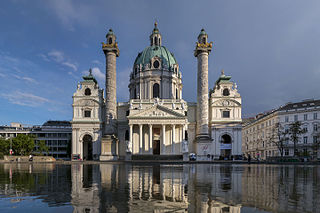
The Rektoratskirche St. Karl Borromäus, commonly called the Karlskirche, is a Baroque church located on the south side of Karlsplatz in Vienna, Austria. Widely considered the most outstanding baroque church in Vienna, as well as one of the city's greatest buildings, the church is dedicated to Saint Charles Borromeo, one of the great counter-reformers of the sixteenth century.
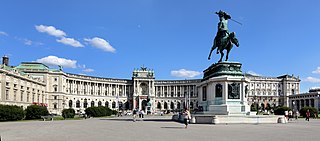
The Hofburg is the former principal imperial palace of the Habsburg dynasty in Austria. Located in the centre of Vienna, it was built in the 13th century and expanded several times afterwards. It also served as the imperial winter residence, as Schönbrunn Palace was the summer residence. Since 1946, it is the official residence and workplace of the president of Austria.

Johann Lukas von Hildebrandt was an Austrian baroque architect and military engineer who designed stately buildings and churches and whose work had a profound influence on the architecture of the Habsburg Empire in the eighteenth century. After studying in Rome under Carlo Fontana, he constructed fortresses for Prince Eugene of Savoy during his Italian campaigns, becoming his favorite architect. In 1700 he became court engineer in Vienna, and in 1711 was named head of the court department of building. He became court architect in 1723. His designs for palaces, estates, gardens, churches, chapels, and villas were widely imitated, and his architectural principles spread throughout central and southeast Europe. Among his more important works are Palais Schwarzenberg, St. Peter's Church, and Belvedere in Vienna, Savoy Castle in Ráckeve, Schönborn Palace in Göllersdorf, and Schloss Hof.
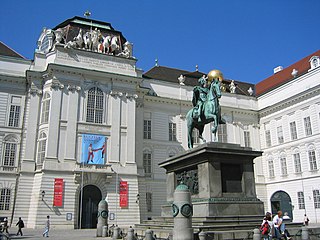
Josefsplatz is a public square located at the Hofburg Palace in Vienna, Austria. Named after Emperor Joseph II, Josefsplatz is considered one of the finest courtyards in Vienna.

Palais Schwarzenberg is a Baroque palace in front of Schwarzenbergplatz, Landstraße, the 3rd district of Vienna, Austria. It is owned by the princely Schwarzenberg family.

Palais Augarten is a Baroque palace in the district of Leopoldstadt, Vienna, Austria. Constructed in the late seventeenth century by Johann Bernhard Fischer von Erlach on the site of a Jagdschloss and gardens, the palace and gardens were expanded in the nineteenth century under Emperor Franz Joseph I of Austria. Despite extensive damage suffered during World War II, the palace has been maintained almost in its original appearance, and many of the original furnishings can still be found there. Today, Palais Augarten is the home and rehearsal space of the Vienna Boys' Choir, who also have their own school there. The palace is located in the 130-acre Augarten park, which is the oldest Baroque garden in Vienna.

Palais Kinsky is a Baroque palace in central Vienna, Austria. It was originally built for Count Wirich Philipp von Daun, the garrison commander whose son Leopold became a Field Marshal of Empress Maria Theresa. The palace was later bought by the Kinsky family of Bohemia, and it is sometimes called the Palais Daun-Kinsky.

Princess Maria Anna Victoria of Savoy was the daughter of Prince Louis Thomas of Savoy, Count of Soissons, and Uranie de La Cropte de Beauvais (1655-1717).

Lorenzo Mattielli was an Italian sculptor from the Late Baroque period. His name has also variously been written as Matielli, Mattiely, Matthielli, and Mathielli. He supplied statuary for palaces and churches in Vienna and Dresden and for the monastery of Melk (Austria).

Joseph Emanuel Fischer von Erlach, also Fischer von Erlach the Younger was an Austrian architect of the Baroque, Rococo, and Baroque-Neoclassical.
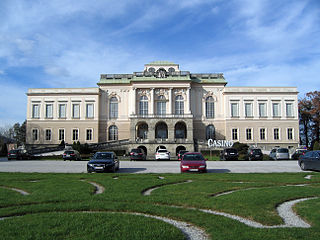
Schloss Klessheim is a Baroque palace located in Wals-Siezenheim, 4 km (2.5 mi) west of Salzburg, Austria. The palace was designed and constructed by Austrian architect Johann Bernhard Fischer von Erlach for Prince-Archbishop Johann Ernst von Thun in 1700. It became the summer residence of the Archbishops of Salzburg. Since 1993, the palace has been used by Salzburg Casino.

Count Johann Wenzel Wratislaw of Mitrovice was a Czech nobleman. He was the High Chancellor of Bohemia. He was the member of the Wratislaw of Mitrovice family.
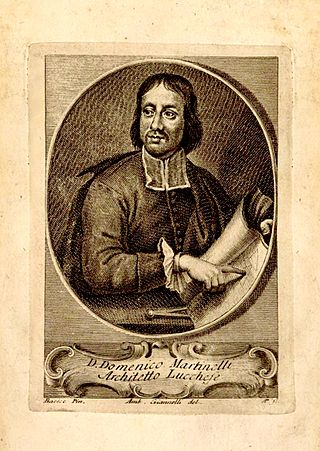
Domenico Martinelli was an Italian architect who worked for Carlo Fontana during 1678. He was an evident figure in the shaping of Baroque style in the North Alps. In 2010 a musical tribute called "Project Martinelli" was performed to him in Munich.
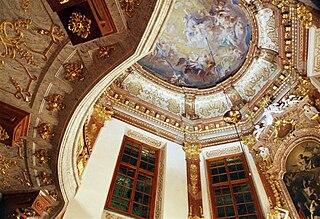
Belvedere Palace Chapel is a chapel located in the south eastern corner tower of the Upper Belvedere in Vienna, Austria. It was designed by the Austrian architect Johann Lukas von Hildebrandt.

The Holy Trinity Church is a Roman Catholic church in Salzburg, Austria. It was designed by Johann Bernhard Fischer von Erlach.

Countess Eleonore Batthyány-Strattmann was a Viennese court lady. The daughter of Imperial Court Chancellor Count Theodor Heinrich von Strattmann und Peuerbach, she was married to Hungarian nobleman and Ban of Croatia Ádám II Batthyány until his early death in 1703. For more than twenty years after becoming a widow she was Prince Eugene of Savoy confidante, companion and some have suggested Éminence grise. One of the most respected women in 18th century Viennese society, she was known as 'Beautiful Lori'.
































